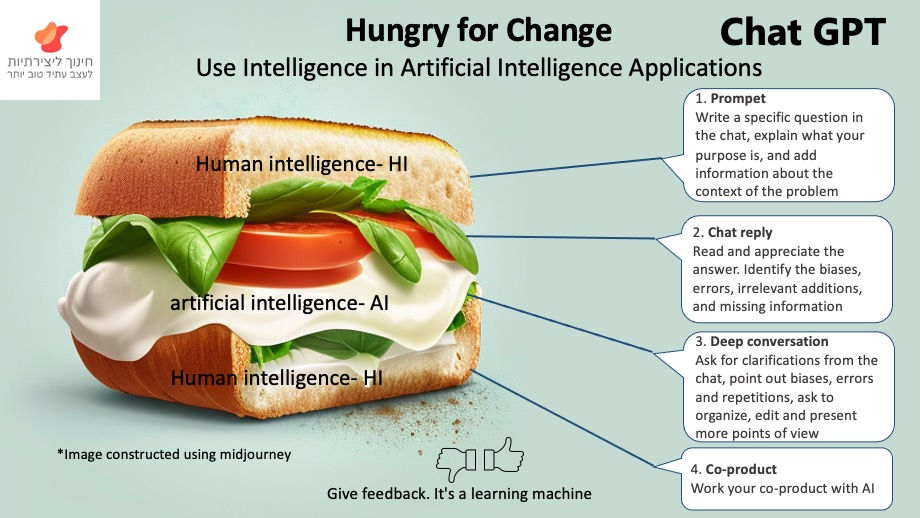Safe Usage Guidelines for ChatGPT - Hungry for change
- Dr. Limor Leibovitz

- Feb 22, 2023
- 2 min read

For over two months, this popular chat platform has been a sensation, attracting millions of daily users, including teachers and students of both genders. They use it for diverse tasks such as:
Crafting headings for academic papers
Creating stories and songs
Scriptwriting
Designing math exercises for various levels
Creating exams in diverse subjects
Planning itineraries
Simulating conversations between historical figures
Developing lesson plans
Generating prompts for apps like DALL-E or Midjourney
Forecasting the impact of AI on different life aspects
And more...
If you have a specific goal in mind, consider using the "sandwich" approach: human intelligence - artificial intelligence - human intelligence.
Explore with your classroom the Safe Usage Guidelines for ChatGPT:
The interaction with the chat can be broken down into four steps:
Prompt: Pose a specific question to the chat, outlining your objective and providing context.
Chat Response: Read and assess the chat's answer for biases, errors, irrelevant content, and omissions.
Deep Conversation: Seek further clarification, point out inaccuracies, and request additional perspectives. Provide feedback to improve the chat's future performance.
Joint Product: Work on the collaborative output, remembering that the AI is an assistant, not a replacement for your efforts.
In this post, I'd like to focus on step 2. When interacting with AI, it's crucial to critically evaluate any biases or inaccuracies. I encourage you to watch a video that illustrates some of the chat's biases concerning well-known characters and new sites.
In this video chatGPT gives a 'self evaluation' of the biases in its training data on a scale from +10 to -10. This issue is crucial given the chat's increasing impact on shaping reality perceptions, particularly in the Western world. The concern extends beyond school assignments to a broader potential for bias in public information. For instance, some news outlets are already employing chat technology to produce content. This could perpetuate existing biases, making the issue of fake news seem minor in comparison. Imagine a scenario where facts become unverifiable because information is overwhelmingly generated by AI.
About a month ago, experts in Media Education convened for a significant conference on Safe Usage Guidelines for ChatGPT and other AI tools. They delved into the ethical challenges, biases, and the necessity for critical disclosures when integrating AI applications.
The meeting included a discussion moderated by Dr. Raviv Nava, secretary of the media and information literacy community.
The discussion dealt with the questions: How will we integrate an artificial intelligence tool in a way that will enhance the opportunities for learning and creation and reduce the risks in education for media literacy, cinema and the arts?
I recommend talking with the students about the limitations of the chat and the possibilities it offers them
To prepare them for a lifetime of fruitful interaction with the machines!
Please register as a member of the site to receive notifications to your email and write comments at the end of the post. Click here to join - Log In.
Additionally, remember that you can also order an inspiring lecture on ChatGPT technology and innovation in education today.
Good luck to all 21st-century teachers!








Comments